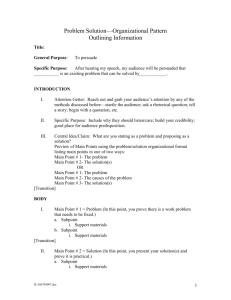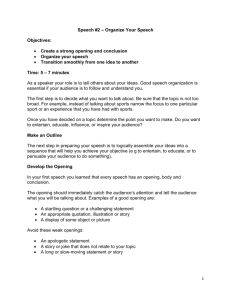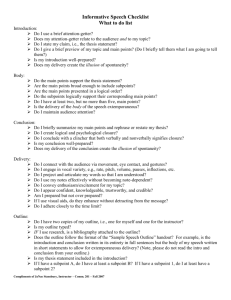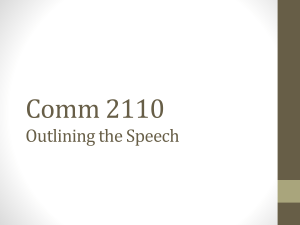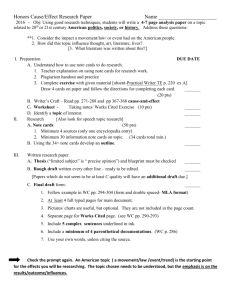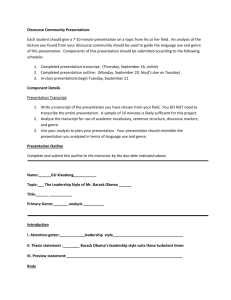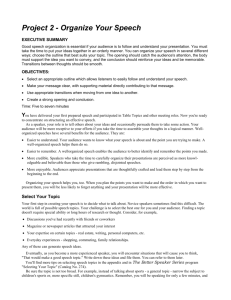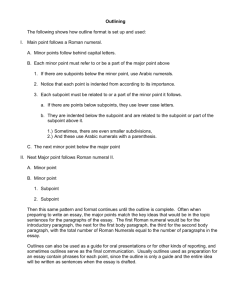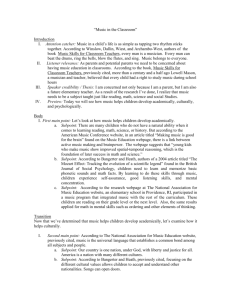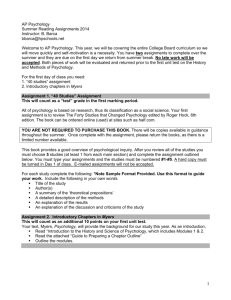Developing an Effective Speech Outline
advertisement
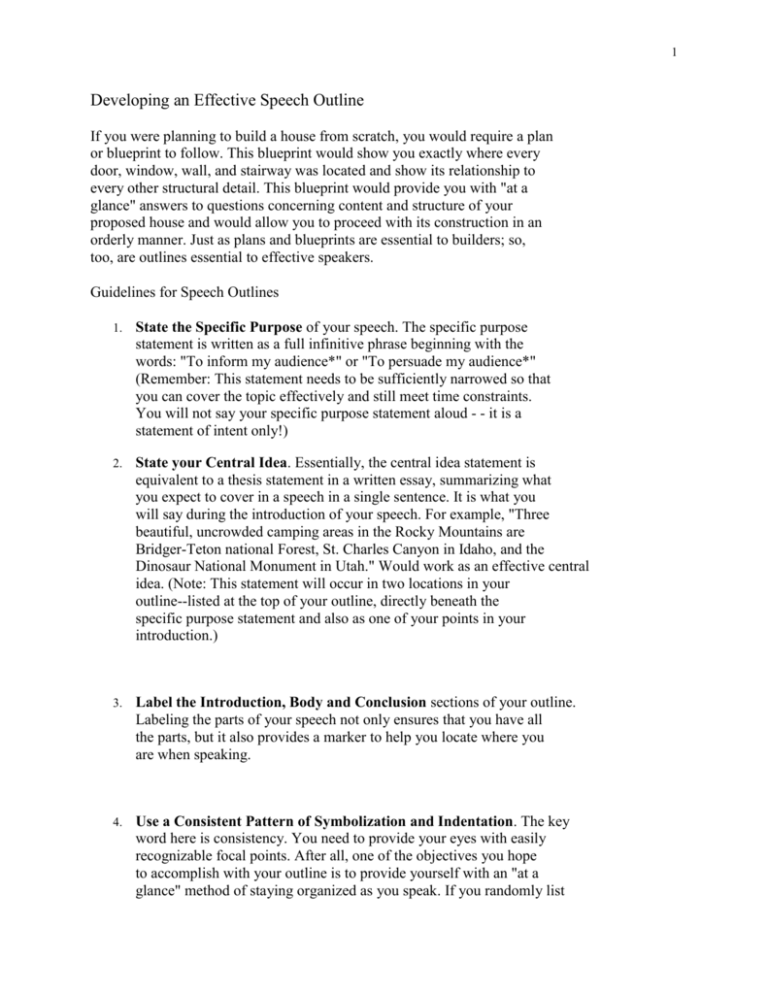
1 Developing an Effective Speech Outline If you were planning to build a house from scratch, you would require a plan or blueprint to follow. This blueprint would show you exactly where every door, window, wall, and stairway was located and show its relationship to every other structural detail. This blueprint would provide you with "at a glance" answers to questions concerning content and structure of your proposed house and would allow you to proceed with its construction in an orderly manner. Just as plans and blueprints are essential to builders; so, too, are outlines essential to effective speakers. Guidelines for Speech Outlines 1. State the Specific Purpose of your speech. The specific purpose statement is written as a full infinitive phrase beginning with the words: "To inform my audience*" or "To persuade my audience*" (Remember: This statement needs to be sufficiently narrowed so that you can cover the topic effectively and still meet time constraints. You will not say your specific purpose statement aloud - - it is a statement of intent only!) 2. State your Central Idea. Essentially, the central idea statement is equivalent to a thesis statement in a written essay, summarizing what you expect to cover in a speech in a single sentence. It is what you will say during the introduction of your speech. For example, "Three beautiful, uncrowded camping areas in the Rocky Mountains are Bridger-Teton national Forest, St. Charles Canyon in Idaho, and the Dinosaur National Monument in Utah." Would work as an effective central idea. (Note: This statement will occur in two locations in your outline--listed at the top of your outline, directly beneath the specific purpose statement and also as one of your points in your introduction.) 3. Label the Introduction, Body and Conclusion sections of your outline. Labeling the parts of your speech not only ensures that you have all the parts, but it also provides a marker to help you locate where you are when speaking. 4. Use a Consistent Pattern of Symbolization and Indentation. The key word here is consistency. You need to provide your eyes with easily recognizable focal points. After all, one of the objectives you hope to accomplish with your outline is to provide yourself with an "at a glance" method of staying organized as you speak. If you randomly list 2 facts all over a sheet of paper, this objective is more difficult to accomplish. Traditionally, main points are identified with Roman numeral (I, II, III, etc.) and begin at the left margin. Subpoints of main points are identified with capital letters (A, B, C, etc.) and are usually indented five spaces from the left margin. Sub-subpoints are indicated by Arabic numerals (1, 2, 3, etc.) and are usually indented an additional five spaces from the subpoints for a total of ten spaces from the left margin. 5. State Main Points and Subpoints in Full Sentences. Using vague labels in an outline does not clearly indicate the content of your speech--what you plan to actually tell your audience. Stating your main points and subpoints in full sentences will ensure that you can fully develop your ideas and can guard against omission of important information. 6. Label Transitions, Internal Summaries, and Internal Previews. Transitions, internal summaries, and internal previews are all devices a speaker uses to connect the ideas she/he is presenting together. Without these connectives, the speech will seem rather disjointed or uncoordinated. (Transitions are words or phrases that indicate when a speaker has finished one idea and is moving on to the next, such as: "in addition," "the other part is*," "now that we have*," "it's time now to discuss*" ) Internal previews are more detailed than transitions and usually indicate when the speaker is moving on to the next main point. For example, "In discussing the problem of America's deteriorating public works system, we shall deal first with our streets and highways, second with our bridges, and third with our water systems" is representative of an internal preview. In long speeches that cover extensive technical information, the speaker often finds it necessary to pause and reiterate key points for the audience. An internal summary reminds the listener what she/he has already heard to make sure she/he has grasped that information before the speaker moves on to the next point. 7. Attach a Bibliography. A bibliography is a list of the books, magazines, and newspapers you consulted in preparing your speech. Use MLA format in noting your bibliography. The key is consistency, clarity of presentation, and accuracy. The bibliography demonstrates the effort you put forth researching the topic and reflects your credibility as a speaker. 3 You may use the format below or the outline form provided Speech Outline Format Specific Purpose: [Type what you plan to accomplish in your speech here. Remember to begin with "To inform (or persuade) my audience*"] Central Idea: [Type the one-sentence summary of the key points to be covered in your speech here.] INTRODUCTION [label the introduction to mark it as a distinct section.] I. Attention Getter II. Relate to audience III. Establish Credibility IV. State central idea and preview main points (Transition: Type the transition from your introduction to your body here.) BODY [label the body of the speech to indicate it is a distinct section.] I. I. Type first main point as a full sentence here. A. Type first subpoint of first main point here. 1. If further elaboration is called for, type the first sub-subpoint of the subpoint here. 2. Type the second sub-subpoint here. If you have one sub-subpoint, you must have at least a second. B. Type the second subpoint here. If you have one subpoint, you must have at least a second. II. Type second main point as a full sentence here. A. Type first subpoint of the second main point here. B. If no further elaboration was necessary on first subpoint, type the second 4 subpoint here. If you have one subpoint, you must have a second. III. Type the third main point as a full sentence here. A. Type the subpoint first of the third main point here. B. If no further elaboration was necessary on the first subpoint, type the second subpoint here. Remember, if you have one subpoint, you must have a second. C. Type the third subpoint here. Conclusion [label conclusion to distinguish it from the body of the speech] I. Signal you are going into conclusion. II. Restate central idea & summarize mainpoints III. End memorably Bibliography Provide a list of sources consulted while preparing your speech, using MLA bibliographic style.
